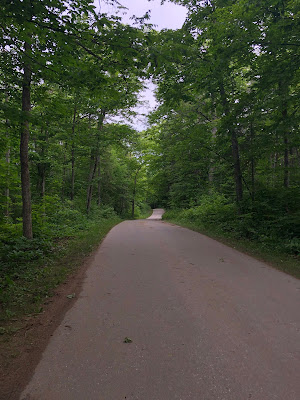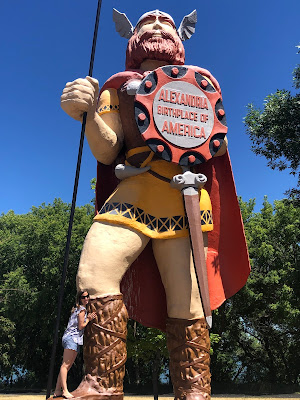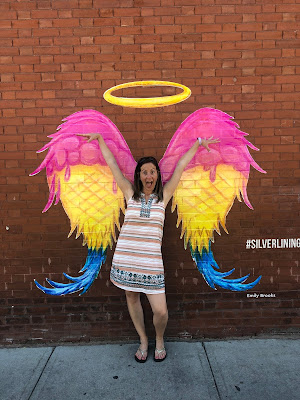When I told people I was coming to North Dakota, they almost all said, “Oh, Mount Rushmore!” I would say, “No, I’ve been there, but that’s South Dakota.” They would say, “Oh, the Badlands!” I would once again say, “No, that’s South Dakota.” (More on that in a minute.) Then, they would say, “Well, what is in North Dakota?”
Before planning for this trip, I probably would have had similar questions. Very few people I know have been to North Dakota, but that’s part of what makes it so intriguing to me! Thankfully, Niki, our 50 by 50 inspiration, had been here and had tips galore to share. Her advise steered us to a little known National Park. Theodore Roosevelt, our conservationist president, loved this part of the country. He ranched here, escaped here, and learned about conservation here. It is because of him that we have an expansive National Parks system, and so it seems only fitting that this park was named after him.
This National Park is not a massive one. An hour and a half around a loop drive can show you a majority of the southern part of the park, but we all know that a drive around means you miss out on so much more.
One of my first questions to a ranger was about the Badlands. I have visited the Badlands National Park in South Dakota, and yet, this area had also been referred to as the badlands, so I asked for clarification. It seems there are several sections of badlands in the Dakotas, named such, I believe, for their lack of ability to harvest nor pass through on ox and wagon. The ranger proudly boasted though, that the badlands here are the oldest.
Jessica and I both love camping and hiking. There is something rejuvenating about it. So, we decided from the start that we wanted several nights at the park. Setting up our tent, blow up mattresses and chairs always takes a little bit of effort, so you want to make sure you’ve got time to really enjoy the home you just built. Our site had bison droppings and a snake slithering toward it when we arrived, truly welcoming us properly. My favorite times at our campsite were our evenings of playing cards, strolls around the campsite, watching stars appear, reading with no distractions and watching bison wander calmly through. Camping allows for the smaller pleasures in life to become the highest priorities.
The weather made our time in the park a little more trying with highs in the upper 80s and 90s, two full days of wind gusts in the upper 20s, and strong thunderstorms two nights (one with a tornado watch), but we made the most of it and found lots to enjoy in this great park. Like most places with lower humidity, shade made a huge difference, but the terrain of this park did not provide a lot of shade. There were trees, yes, but aside from the cottonwoods in our campsite, they were more sporadic, and also quite “limby,” so getting under their shade was problematic.

The park is made up of a seemingly endless amount of buttes as far as the eye can see. A butte may appear like a mountain, but the difference in their categorization has to do with how they are formed. Mountains grow up from the ground while buttes are broken down from erosion. So, at one point, all of this land was the same height, but years of erosion have created buttes and canyons. The tall buttes have clearly distinguishable lines of color showing age and periods of erosion.
Wildlife in the park was plentiful! There are no bears in the area, so that made life a little easier taking away that fear. Bison were everywhere, sometimes on their own, sometimes in large groups of thirty or more. They wandered across the road and through campsites, showing that this land was theirs and not ours. We did some research and learned that these are bison, not buffalo, even though for years, Americans have used the terms interchangeably.
Prairie dogs were in huge supply; their towns were marked on the map of the park. Some of my favorite parts of hikes were the walks through their towns. They scurried about, chirped at us and wagged their tails before going back into their burrows. This is a favorite video of ours, so we walked through the towns calling “Allen” and “Steve,” but no one responded. Researchers have determined that prairie dogs have a complex language system and even have different sounds for color and number. We heard many a variety of chirps and squeaks!
We spotted deer and rabbits (one that even hopped toward me on the path before stopping to scratch his ear within a yard of me, so I almost gained a pet bunny!). Prong-horns were a common site as well. Through some research, we learned that they are not actually antelope. While they look fairly similarly, antelope are of a different genetic make up found in Africa. A major difference is that antelope have antlers (that come and go), but prong-horns have horns. So, the classic song has two out of the three animals named incorrectly.
One of our favorite creatures to spot was not an uncommon one, but they are rare to see in the wild. When this became a park in 1954, a few of the horses living here eluded capture. Their descendants are now carefully managed, but still remain wild and free to roam the park. There were birds a plenty, and they happily sang throughout the day. Crickets, too, usually an evening sound, could be heard throughout the day across the grasslands. We saw a snake, but thankfully at a safe-distance and with no visible rattle. We heard coyotes at night, but never saw them. And the elusive porcupines kept to themselves.
Our first hike was one from Peaceful Valley Canyon. We had to cross the Little Missouri almost immediately (little being a key word). It was no more than ten yards wide and at its deepest was about a foot and half deep. So, besides the difficulty of taking on and off our boots, it was pleasantly refreshing. The rivers here are muddy, because of continuous erosion. We walked through prairie dog towns and winded through the valley of the buttes, but perhaps unwisely we chose the ten mile loop instead of the five. Parts of the trail were tricky, crossing over tiny muddy tributaries, but mostly, it was fairly flat, walking through sage brush and prairie grasses. The most remarkable part of the trail was after just a slight climb we ended up on a prairie plateau with nothing visible for as far as the eye could see. It was a drastic change from the desert/tundra-like valley we had just walked through. It was also a reminder that this whole area at one point had been like that. The tall land provided us with sweeping views of the landscape and made the hot long trek well-worth it.



The petrified forest was another part of the park that we wanted to see, and it did not disappoint. The starting point for the trail is a little out of the way, along a dirt road that is not accessible after heavy rains. There are two small sections of the park that are parts of petrified forests, and we chose to visit the southern one. For about a quarter of a mile along the trail, you find petrified tree stumps and logs littering the ground. It was fascinating to see, and mind-boggling. Chips of “wood” are scattered about but if you touch them or attempt to lift them, you see that in fact, they are stone, despite their appearance. From a little internet searching, what I understand is that this area was once (millions of years ago) a warm climate with lots of water, not too dissimilar to the Everglades. Heavy rains buried the trees under lots of mud, depriving them of oxygen which helps them to deteriorate. Instead, minerals that help in rock formation attached to the trees and slowly, while keeping the appearance of trees, they turned to stone.


The one near perfect day that we had, with clear skies and highs in the mid-70s we should have spent hiking, but we chose a different rejuvenating option. We chose to have a lazy start to the day, then spent the afternoon with our chairs down by the river, watching bison doing the same thing on the other side. We chose to read, they mostly lazed about and tried to rid themselves of the flies. Sometimes just being is the best way to enjoy nature.

We spent more time in the town of Medora than we originally planned because of the weather. Niki had described it as “a sweetheart of a town,” and she was not wrong. Year-round it boasts a population of about one hundred twenty people, but that swells during the summer months. There are about a dozen gift shops, ice cream parlors, fudge shops, a candy shop, a handful of restaurants and a putt putt course and playground perfectly themed to the area. An art gallery and small museum about the inventor of Mr. Bubbles was a great deterrent on a hot blustery day. There is a large manor where the founder of this town, a wealthy Frenchman and his wife (who the town was named after) once lived. There also, shockingly, is a booming theatre industry, where, during the summer months, multiple performances occur each day in multiple venues. On a particularly hot blustery day, we chose to spend $15 to sit in air conditioning for an hour, and enjoyed it much more than we anticipated. A Theodore Roosevelt expert, and look-alike, shared knowledge of the President, his love for this part of the country, and interacted with the audience in a truly captivating way. We missed out on the ever popular Medora Musical, but then again, we must leave something to come back to!

 |
| Playground in Medora |
Everyone that we met in this town blew us away with their kindness. The shop-owners, wait staff in restaurants, and rangers all went above and beyond, carrying on conversations and greeting us with warm, genuine smiles. The woman in the office for the Roosevelt Presidential Library, where we sort of accidentally inserted ourselves, could not have been friendlier and shared information with us about the upcoming build (scheduled to open in 2025). The gentleman in the candy shop led us to the Theodore Roosevelt play along with other helpful hints.
On our last day, we chose to drive an hour to the North Unit of the park, still under the same name, but a total separate piece of land. More buttes, vast landscapes, and canyons formed by the Little Missouri greeted us in the North. There are supposedly a herd of long-horns there as well as big horned sheep, but they wisely sought refuge elsewhere in the heat of the day. Cannonball Canyon was a unique geological area where, somehow, of which I still don’t understand, round, reddish rocks have formed and appear to litter the ground.

We chose a four-mile loop hike in the park that took us through strikingly different landscapes in a short amount of time. Starting at the base of the buttes, we ended up climbing through a dense forest before arising on top of a butte with incredible views. A lookout point shows where the river takes a sharp curve because an ancient glacier blocked its way. And now the slow moving river floods frequently providing a perfect place for cottonwood trees to thrive.


On our last night in the park, we drove further into the park to watch the sunset from a high peak, Buck Hill. The light danced across the canyons and buttes, creating soft golden hues. Anytime I get to watch the sunset seems like a gift, and watching it from such a stunning vista was a lasting gift. Not only was the view and the color of the sky incredible, but the amount of wildlife we saw on the road to and from added to the excitement. A herd of bison, including many young ones crossed on the road in front of us. Turkey and deer used a similar crossing spot. Horses seemed to know that their silhouettes were best admired in the setting sun, and so they strutted around and did their best to make drivers stop and notice them. An owl swooped low on the road just in front of us, but the porcupine stayed hidden. 


I’m not sure if and when I’ll make it back to Theodore Roosevelt National Park, but I’m so very thankful I’ve gotten to see the beauty it provides of this unique landscape and thriving wildlife. Let me know when you’re ready to come, I’ll happily help you plan your trip!


































































